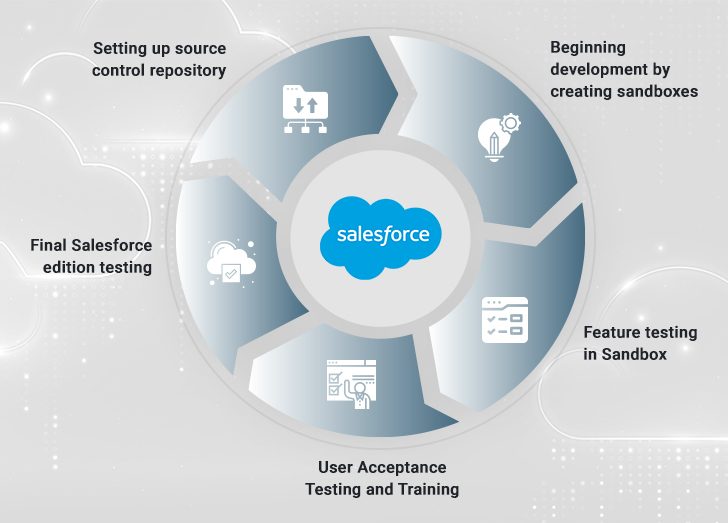Establishing a seamless development lifecycle is pivotal when it comes to developing an app. Experienced software developers spend quite a lot of time ensuring that the lifecycle is secure, fast, and foolproof and results in a product that actually exceeds expectations. Multiple software development approaches, like the agile development model and the waterfall model, were born out of this optimization. Nevertheless, each project and business needs a little modification to the standard approach of software development. The same goes for the Salesforce development life cycle. When it comes to Salesforce AppExchange app development, the basic premise of software development stays the same, the slight difference that arises is because of the cloud-based environment of AppExchange. The marketplace plays a key role in enabling businesses to extend and boost the capabilities of the Salesforce platform.

Before we understand the lifecycle of Salesforce AppExchange app development, let’s have a quick look at the key steps involved in a typical development lifecycle of a Salesforce project.
Common Steps Involved in the Salesforce development lifecycle:

Multiple sub-steps are involved in this process and in case the code fails at any step, it goes back to the development part.
Understanding Salesforce AppExchange App Development Lifecycle
For developing an app to be published on AppExchange, the lifecycle of development becomes a bit complex and more involved. For projects targeted at end users, the user feedback also acts as a reason for reverting to the development phase. The typical AppExchange app development life cycle includes the below-mentioned steps:
1. Ideation
Innovation is the first step in creating an app. Salesforce AppExchange partners spearhead these ideas, spotting inefficiencies or gaps in the current processes and devising solutions that address the challenges. The ideation phase is important as it lays the groundwork for the whole development process. Brainstorming sessions, market analysis, and feedback play a critical role in this phase. To refine and validate their ideas, AppExchange partners work with Salesforce administrators, stakeholders, and potential end-users. This approach guarantees that the proposed app fits the market needs and works well with the Salesforce ecosystem.
2. Building Strategy
Once the idea is confirmed, the next step is to plan in detail and strategize. This helps build a roadmap highlighting the scope, functionality, and features of the app. AppExchange partners should define their target audience, create a differentiator, and take the customization capabilities of the app into account. Comprehensive planning also includes defining user experience and user interface design, determining the technological stack, and laying out the development schedule. A well-designed strategy guarantees that the app aligns with the goals of the business and connects with the users.
3. Beginning Development
Once the plan is put into place, it’s time to begin the development phase and turn ideas into reality. Salesforce AppExchange app development includes processes like coding, testing, and refining the app to make sure it meets the quality standards. Salesforce provides a robust development environment to be used by developers. Apex is utilized for backend functionality and Lightning components for frontend design.
To address particular business needs and boost the efficiency of your CRM, AppExchange needs customization. AppExchange partners work with experienced developers to comprehend the complexities of the Salesforce platform and optimize the app for performance, scalability, and security. Continuous testing is vital throughout the process of development to address any issues in a prompt manner. With the help of rigorous testing, you can ensure that your app is both functional and user-friendly.
Innovate, Integrate, and Inspire with Salesforce AppExchange Development.
4. Ensuring Trustworthiness
Trustworthiness is ensured with Salesforce Security Review. It is a crucial stage in the AppExchange app development lifecycle and ensures that the security and privacy standards are met by the app. The security review process assesses the architecture, data handling practices, and general security measures of the app.
Apps must pass the security review to be listed on the AppExchange marketplace. Hence, it is vital that Salesforce AppExchange Partners navigate this process effectively. This step builds trust among users and reassures them that the app is secure for integration into their Salesforce instances.
5. Listing on AppExchange
After the AppExchange app has successfully passed the security review, it becomes ready to be listed on the AppExchange marketplace. This platform offers unmatched visibility, making the app accessible to a large user base. A well-designed listing includes intriguing descriptions, customer testimonials, and eye-catching visuals that depict the value proposition of the app.
Salesforce AppExchange Partners make use of multiple marketing strategies to promote their app on the marketplace. These strategies include webinars, social media campaigns, and collaborations with other players in the Salesforce ecosystem. The search and filtering capabilities of AppExchange ensure that it becomes easier for potential users to discover and evaluate the app, promoting installations and downloads.
6. User Feedback
After the app is listed on AppExchange, the journey does not end there. It rather enters a stage of continuous enhancement and evolution based on user feedback. Salesforce AppExchange Partners need to proactively engage with users, collect feedback, and evaluate usage patterns to recognize areas of improvement.
AppExchange Partners can release updates that cater to user needs, fix bugs, and introduce new features using open lines of communication with the user community. This process improves the functionality of the app and creates a feeling of community around the product
7. Customization and Scaling
With the growth of the user base, AppExchange partners tend to encounter myriad use cases and business requirements. This is where scaling and customization become important to address the specific needs of various organizations. This phase involves expanding the capabilities of the app, integrating extra features, and guaranteeing compatibility with multiple Salesforce editions. Scalability helps accommodate the increasing volume of users and data. AppExchange partners can also choose to provide different licensing models or pricing plans to ensure the app becomes accessible to a wider audience base.
8. Regular Maintenance
Continuing support and maintenance are part of the final stage of the AppExchange app. This includes resolving any problems, offering updates on schedule, and guaranteeing compatibility with new Salesforce releases. To maintain a quality user experience, Salesforce AppExchange Partners need to be proactive in responding to customer queries and technical issues.
Regular maintenance helps ensure the reliability of the app and also contributes to its continued success on the AppExchange marketplace. It solidifies the reputation of the Salesforce AppExchange Partner as a reliable supplier focused on offering innovation and value.
Summing Up
The lifecycle of Salesforce AppExchange app development is a journey that requires innovation, strategic planning, meticulous execution, and continuous improvement. AppExchange Partners play a critical role in shaping the Salesforce ecosystem by offering solutions that boost the capabilities of the platform. From the ideation phase to the ongoing maintenance and support, every step plays a key role in the success of an AppExchange app. The marketplace provides a platform for visibility and encourages a community where businesses can discover and evolve with innovative solutions.
The importance of the AppExchange marketplace continues to grow as businesses increasingly depend on Salesforce for streamlining their business operations. By comprehending and navigating the lifecycle of AppExchange app development, AppExchange partners can discover new opportunities, foster innovation, and add to the overall success of the Salesforce ecosystem.
AppExchange vs Custom Development: Making a Conscious Choice in Salesforce





